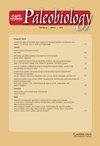岩石记录中因果关系的保存
IF 2.6
2区 地球科学
Q2 BIODIVERSITY CONSERVATION
引用次数: 2
摘要
摘要进化事件可能通过硅酸盐风化的短暂不平衡影响地质碳循环,这些事件被认为是冰川作用、大灭绝和海洋缺氧的原因。然而,所提出的进化原因往往大大早于它们所关联的环境影响——当碳循环扰动必须在不到一百万年的时间内得到解决以保持地球的宜居性时,这就成了问题。更重要的是,这种扰动的地球化学特征是在广泛分布的海洋沉积岩中记录的,这些沉积岩在地球历史上的重要时期都进行了密集采样,而化石记录——尤其是在陆地上——则由沉积盆地的可用性决定,这些沉积盆地在空间和时间上都是不完整的,进化谱系的起源与其在化石记录中最早出现之间必然存在滞后。在这里,我们提出了一个保存过滤对采样影响的简单模型,以表明通过风化不平衡引起环境扰动的进化事件在岩石记录中不应该比扰动本身更早出现,如果有什么不同的话,应该更晚而不是同时出现。泥盆纪-汉伯格冰川作用提供了一个例子,说明进化事件如何被更有效地视为环境扰动的潜在原因。正如在大灭绝中消失的物种的最后一次采样预计将在真正的环境事件之前进行一样,首次出现应该会推迟一个谱系对环境影响的地质表达,这对我们阅读地球历史具有重要意义。本文章由计算机程序翻译,如有差异,请以英文原文为准。
The preservation of cause and effect in the rock record
Abstract. Evolutionary events may impact the geological carbon cycle via transient imbalances in silicate weathering, and such events have been implicated as causes of glaciations, mass extinctions, and oceanic anoxia. However, suggested evolutionary causes often substantially predate the environmental effects to which they are linked—problematic when carbon cycle perturbations must be resolved in less than a million years to maintain Earth's habitability. What is more, the geochemical signatures of such perturbations are recorded as they occur in widely distributed marine sedimentary rocks that have been densely sampled for important intervals in Earth history, whereas the fossil record—particularly on land—is governed by the availability of sedimentary basins that are patchy in both space and time, necessitating lags between the origination of an evolutionary lineage and its earliest occurrence in the fossil record. Here, we present a simple model of the impact of preservational filtering on sampling to show that an evolutionary event that causes an environmental perturbation via weathering imbalance should not appear earlier in the rock record than the perturbation itself and, if anything, should appear later rather than simultaneously. The Devonian Hangenberg glaciation provides an example of how evolutionary events might be more fruitfully considered as potential causes of environmental perturbations. Just as the last samplings of species lost in mass extinction are expected to come before the true environmental event, first appearance should be expected to postdate the geological expression of a lineage's environmental impact with important implications for our reading of Earth history.
求助全文
通过发布文献求助,成功后即可免费获取论文全文。
去求助
来源期刊

Paleobiology
地学-古生物学
CiteScore
5.30
自引率
3.70%
发文量
38
审稿时长
>12 weeks
期刊介绍:
Paleobiology publishes original contributions of any length (but normally 10-50 manuscript pages) dealing with any aspect of biological paleontology. Emphasis is placed on biological or paleobiological processes and patterns, including macroevolution, extinction, diversification, speciation, functional morphology, bio-geography, phylogeny, paleoecology, molecular paleontology, taphonomy, natural selection and patterns of variation, abundance, and distribution in space and time, among others. Taxonomic papers are welcome if they have significant and broad applications. Papers concerning research on recent organisms and systems are appropriate if they are of particular interest to paleontologists. Papers should typically interest readers from more than one specialty. Proposals for symposium volumes should be discussed in advance with the editors.
 求助内容:
求助内容: 应助结果提醒方式:
应助结果提醒方式:


